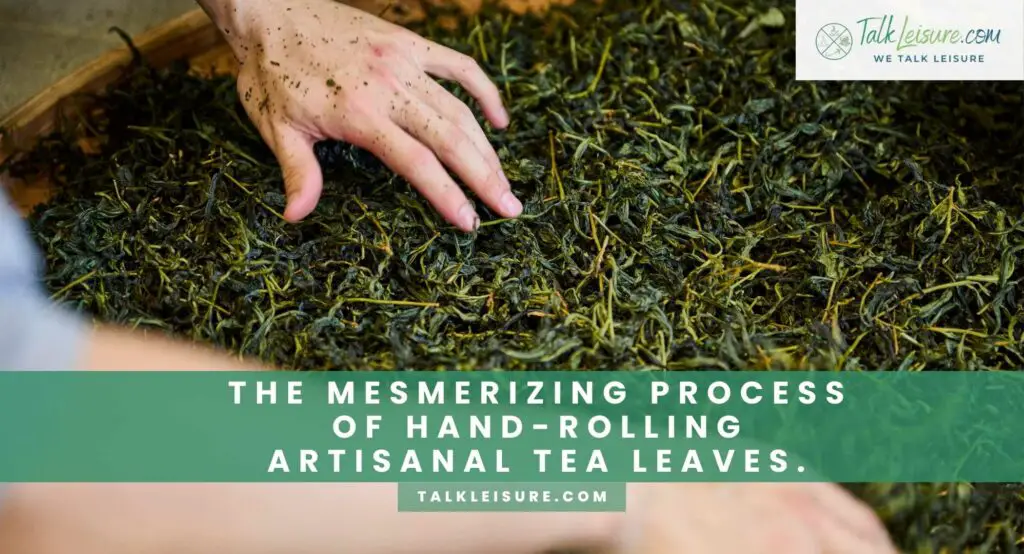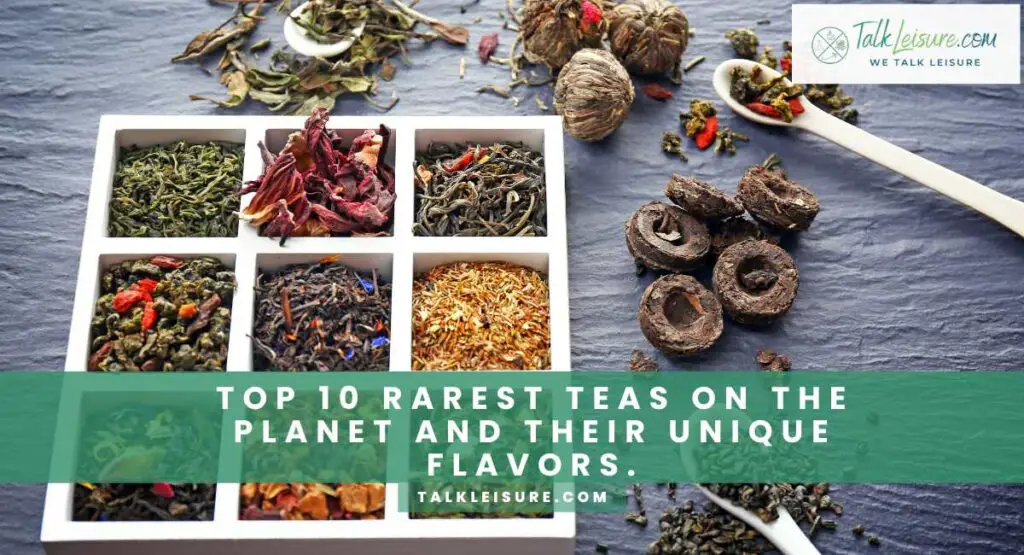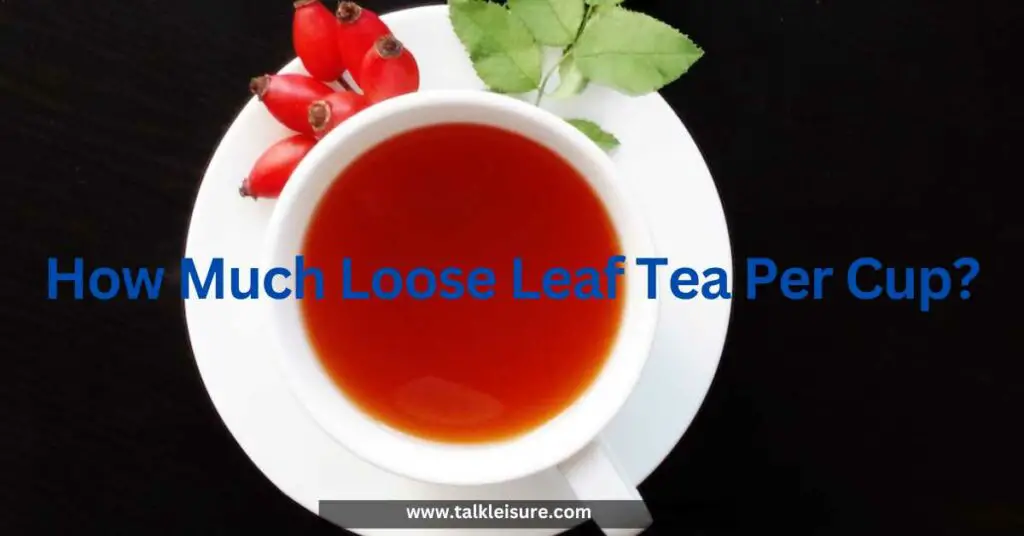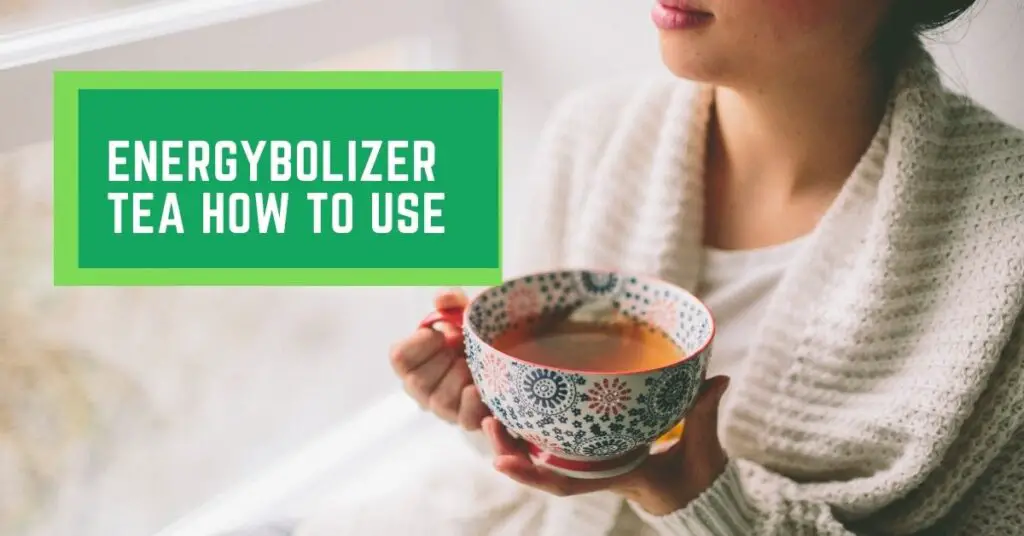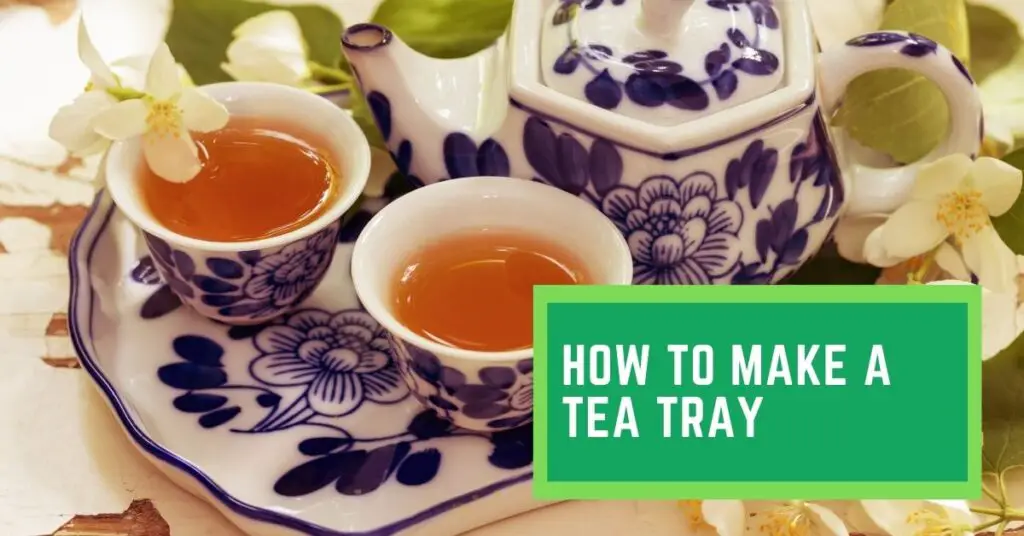In the world of tea, steeping is an art form, a delicate dance between leaves and water that transforms a humble cup into a sensory masterpiece. From the ideal infusion time to the science behind it, every detail matters.
For a balanced brew, use 200°F (93°C) water for black tea, steeping for 3-5 minutes. Green tea prefers 175°F (80°C) for 2–3 minutes. Adjust time and temperature based on tea type and personal taste for a perfect cup.
This comprehensive guide dives into the intricacies of tea-steeping, exploring factors like water temperature, oxidation levels, and even the impact of altitude and humidity. We’ll uncover the secrets of multiple steepings and the alchemy of herbal infusions. Join us on this aromatic journey, and let’s unlock the full potential of every tea leaf, one perfectly steeped cup at a time.
Also read: Top 10 rarest teas on the planet and their unique flavors.
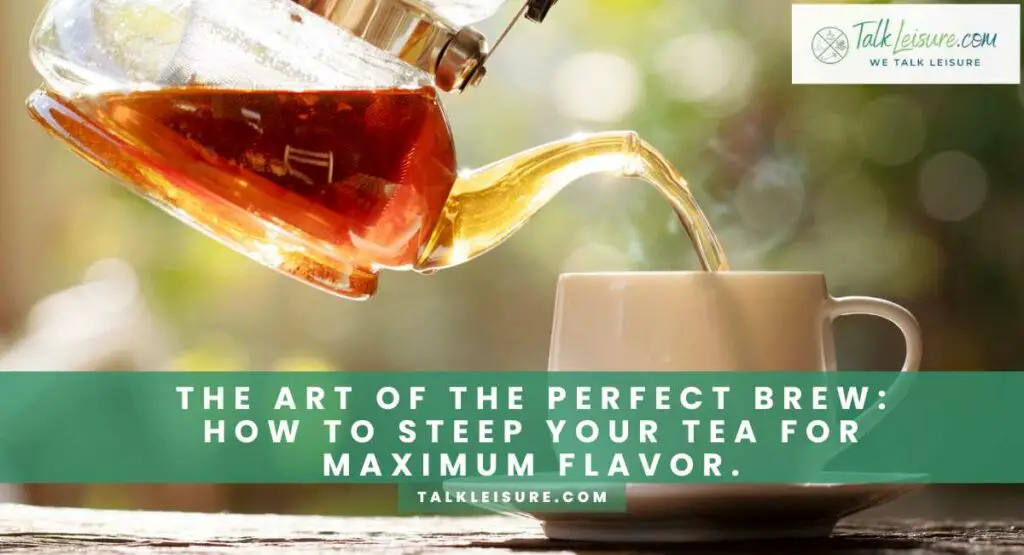
What is the Ideal Steeping Time?
Ah, the elusive art of perfecting the steeping time! It’s the magical moment when dried leaves transform into a flavorful elixir. But how long is too long? And how short is too short? Fear not, my fellow tea enthusiasts, for we’re about to embark on a journey to unravel this mystery!
The ‘Goldilocks Zone of Tea Steeping
Much like Goldilocks and her quest for the perfect porridge, finding the right steeping time is all about hitting that sweet spot. Too long, and your tea may start to resemble a science experiment gone awry. Too short, and you’re left with a lukewarm disappointment.
Black Teas and Green Teas
As a general rule, black teas are like the marathon runners of the tea world. They require a bit more time to strut their stuff, typically around 3 to 5 minutes. Green teas, on the other hand, are more like sprinters. A quick 2 to 3 minutes is all they need to show their vibrant colors.
White Teas: The Wallflowers
Now, white teas, well, they’re the wallflowers of the bunch. Delicate and shy, they prefer a gentle infusion, around 4 to 5 minutes. Remember, they’re not hiding; they’re just taking their time to unfold their subtle charm.
Herbal Infusions
And let’s not forget about herbal infusions! These rebels don’t play by the rules of camellia sinensis. They dance to their own tune, often requiring a bit more freedom, roughly 5 to 7 minutes, to release their full flavor potential.
The Oolong Odyssey
Now, oolong teas are the adventurers of the group. They thrive in that 4 to 7 minute window, straddling the line between green and black with their semi-oxidized glory.
Maté and Pu-erh
Maté and Pu-erh teas, strong and robust, march to their own drumbeat. They can handle a longer steeping time, ranging from 5 to 10 minutes, for a truly bold and invigorating cup.
Experimentation: Your Trusty Sidekick
Remember, these are just guidelines, not laws etched in stone tablets. Feel free to play the maverick, adjust your steeping time, and embark on your own tea-tasting odyssey. Who knows? You might just stumble upon your own perfect brew-time nirvana!
So, dear reader, the next time you’re steeping your favorite blend, remember this: timing is everything, but there’s no one-size-fits-all answer. Embrace the experimentation, savor the journey, and revel in the delightful surprises that a perfectly steeped cup of tea can bring.
Water Temperature and Its Impact on Steeping

Ah, the temperature of the water, a critical player in the grand tea-steeping orchestra! It’s not just about how hot it is, but how it influences the dance of flavors. Let’s explore the delicate balance between heat and time.
Finding the Right Temperature
Tea, much like people, has its own preferences when it comes to temperature. Too hot, and you might scorch delicate leaves. Too cool, and the flavors might never fully develop. It’s all about striking that perfect balance.
Optimal Water Temperatures for Different Tea Types
| Tea Type | Water Temperature | Steeping Time (Minutes) |
| Black Tea | 200°F (93°C) | 3 – 5 |
| Green Tea | 175°F (80°C) | 2 – 3 |
| White Tea | 185°F (85°C) | 4 – 5 |
| Oolong Tea | 195°F (90°C) | 4 – 7 |
| Herbal Infusion | 212°F (100°C) | 5 – 7 |
| Maté/Pu-erh Tea | 200°F (93°C) | 5 – 10 |
Black Tea: Boisterous Heat
Black teas, bold and robust, thrive in the embrace of hot water. Let the kettle sing to 200°F (93°C), and allow the leaves to dance for 3 to 5 minutes. This temperature releases the hearty flavors and aromas, resulting in a satisfying brew.
Green Tea: Gentle Warmth
Green teas prefer a more delicate touch. Bring the water to a gentle 175°F (80°C), and let the leaves steep for a modest 2 to 3 minutes. This lower temperature preserves the fresh, grassy notes that define green tea.
White Tea: Soft Embrace
White teas, the delicate darlings of the tea world, enjoy a warm caress at 185°F (85°C). Let them steep for 4 to 5 minutes, allowing their subtle, ethereal flavors to unfurl in the water.
Oolong Tea: Balancing Act
Oolong teas revel in the in-between. Set the water at 195°F (90°C), and let the leaves dance for 4 to 7 minutes. This temperature range captures the complex interplay between green and black tea, resulting in a harmonious cup.
Herbal Infusions: Boiling Brilliance
Herbal infusions, being the rebels they are, require the full force of boiling water at 212°F (100°C). Let them steep for 5 to 7 minutes, allowing their vibrant flavors to shine through without reservation.
Maté/Pu-erh Tea: Bold and Boiling
Maté and pu-erh teas are the bold contenders, capable of withstanding the heat. Set the water at 200°F (93°C) and let them steep for a robust 5 to 10 minutes. This high temperature allows their deep, earthy flavors to come to the forefront.
So, dear reader, remember that water temperature is the conductor of this grand tea-steeping symphony. With the right balance, you’ll coax out the full array of flavors, creating a cup of tea that’s nothing short of perfection.
Cold Water Steeping: An Alternative Approach

Ah, we’ve explored the hot, steamy side of tea, but what about the cool, refreshing alternative? Cold water steeping is a delightful departure from tradition, offering a unique perspective on tea preparation. Let’s dive into this chilled-out adventure!
Embracing the Chill
Cold water steeping is like a spa day for your tea leaves. It’s a gentle, unhurried process that allows the flavors to unfold at their own leisurely pace.
The Patience Pays Off
This method is perfect for those who relish in the art of anticipation. Cold water steeping takes its sweet time, typically requiring several hours to overnight. It’s a slow dance of flavors, resulting in a subtly nuanced brew.
Black Tea: Bold and Chilled
Even the bold black teas can find their zen in cold water. Place them in the fridge for about 4 to 8 hours, and you’ll be rewarded with a mellow yet robust infusion. It’s a refreshing twist on a classic.
Green Tea: A Gentle Soak
Green teas, those vibrant and lively dancers, also have a place in the cold water ensemble. Let them wade in cool water for 6 to 12 hours, unveiling a delicate, crisp flavor profile that’s perfect for a sunny afternoon.
White Tea: The Subtle Symphony
White teas, known for their delicate nature, shine in this chilled setting. Allow them to steep in cold water for 6 to 12 hours, and you’ll be greeted with a nuanced, ethereal brew that’s sure to captivate your taste buds.
Herbal Infusions: Cool Rebels
Herbal infusions, ever the nonconformists, take to cold water like a fish to, well, cool water! Give them a leisurely 8 to 12 hours to work their magic, and you’ll be treated to a refreshing, aromatic elixir.
Maté and Pu-erh: Embracing the Chill
Even the bold mates and pu-erhs can play the cold water game. Let them steep for 6 to 12 hours, unveiling a rich, invigorating brew that’s perfect for an early morning pick-me-up.
The Art of Decanting
Once your tea has enjoyed its chilled bath, decant it into a glass, and take a moment to savor the unique flavors. It’s a cool, crisp experience that’s bound to become a new favorite in your tea repertoire.
So, dear reader, whether you’re in a rush or just feeling a bit unconventional, cold water steeping is a delightful option to explore. It’s a leisurely, refreshing way to coax out the flavors, offering a whole new perspective on the world of tea.
What is the Science Behind Steeping?
Ah, the alchemy of steeping! It’s not just a simple dance of hot water and leaves; it’s a fascinating interplay of chemistry and magic. Let’s peel back the curtain and delve into the science that turns humble leaves into liquid gold.
The Dance of Solubility
At its core, steeping is a dance of solubility. As the hot water cascades over the tea leaves, it’s like a gentle coaxing, urging the flavors and compounds to dissolve and mingle. This is where the true magic happens.
Extracting Flavor Compounds
The key players in this waltz are the flavor compounds locked within the tea leaves. Polyphenols, catechins, and volatile oils are coaxed out, each contributing its unique character to the brew. The temperature of the water, the type of tea, and the duration of the dance all influence which compounds make it into the final act.
The Role of Temperature
Temperature plays the role of conductor in this symphony. Hot water opens up the tea leaves, allowing the flavors to be released. Too hot, and you risk a bitter brew as harsh tannins take center stage. Too cool, and the dance slows to a crawl, leaving you with a lackluster performance.
The Art of Timing
Steeping time is the choreography that determines the intensity and depth of flavor. Early on, the dance is subtle, with delicate notes taking the lead. As time progresses, bolder flavors step forward, painting a fuller, more complex palate.
Balance and Harmony
The best brews find that delicate balance, where no one flavor overwhelms the ensemble. It’s a symphony of taste, with each note playing its part to create a harmonious and satisfying cup.
The Ritual and the Reward
As you steep your tea, take a moment to appreciate the science at play. It’s not just water and leaves; it’s a carefully orchestrated performance that culminates in a cup of comfort, warmth, and flavor.
So, the next time you’re enjoying a perfectly steeped cup, remember the silent chemistry that made it possible. It’s a testament to the wonders of nature and the age-old art of tea-making.
Should We Stir While Steeping?

Ah, the age-old question: to stir or not to stir? As we navigate the delicate process of tea-steeping, this query often arises. Let’s embark on a journey to uncover the mysteries behind this tea-time conundrum.
The Gentle Art of Steeping
Steeping is, at its heart, a patient and passive affair. It’s a dance of water and leaves, a choreography of flavors, if you will. But should we intervene with a stir, disrupting this delicate performance?
The Tea Leaf Ballet
Tea leaves, much like dancers on stage, have a natural inclination to unfurl and release their flavors. Stirring, while well-intentioned, can sometimes lead to a rushed performance. It’s akin to telling a dancer to skip a step or two in their routine.
The Exceptions to the Rule
While most teas prefer a hands-off approach, there are a few rebels in the tea world. Some herbal infusions and blends benefit from a gentle nudge, especially if they contain larger, chunkier ingredients. A slight stir can help ensure an even distribution of flavors.
Embrace the Teapot Swirl
If you’re using a teapot, a gentle swirl can be a graceful alternative to stirring. It encourages the leaves to mingle with the water, fostering a harmonious infusion. Think of it as a waltz rather than a boisterous jig.
Patience: The Virtue of Tea-making
Ultimately, patience is the unsung hero of tea-steeping. Allow the leaves the time they need to unfold and release their full potential. Trust in the process, and you’ll be rewarded with a brew that’s nothing short of sublime.
The Zen of Tea-Making
In the end, it’s about finding your own rhythm in the art of tea-making. Some teas may call for a gentle stir, while others prefer a quiet solitude. The beauty lies in the intuitive connection you develop with your tea and the delightful surprises it brings.
So, dear reader, as you stand at the precipice of your next steeping adventure, remember this: sometimes, the best course of action is simply to let nature take its course. Allow the leaves to perform their silent ballet, and you’ll be treated to a cup of tea that’s truly enchanting.
Factors Affecting Steeping: Altitude and Humidity
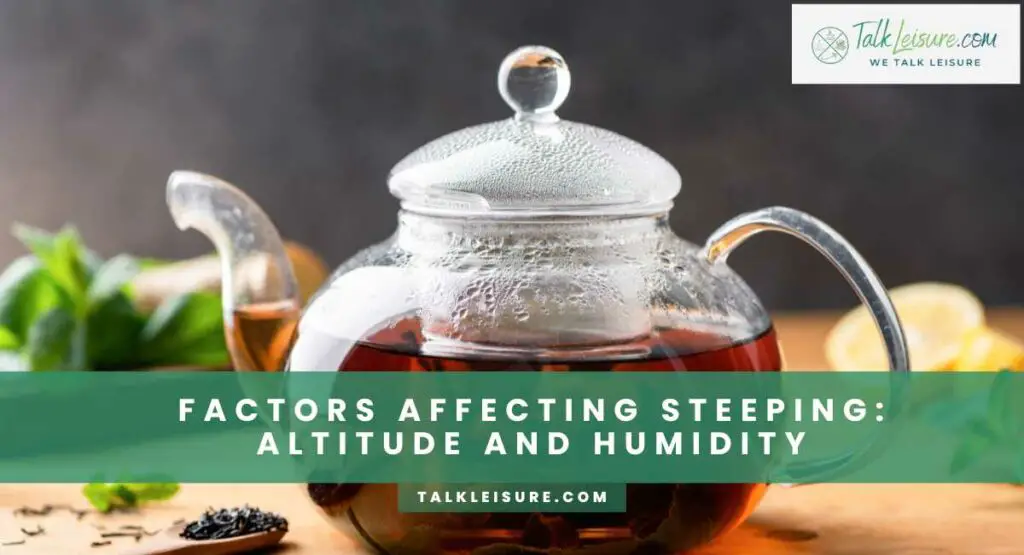
Ah, dear reader, as we delve deeper into the world of tea-steeping, it’s important to recognize that nature has its own say in this delicate dance. Altitude and humidity, often overlooked, are silent players that can significantly influence the outcome of your brew. Let’s unravel their secrets.
Altitude: Where Tea Meets the Sky
Altitude, that silent sentinel in the tea gardens, holds more sway than one might imagine. The air pressure and oxygen levels change with elevation, and this, in turn, affects the boiling point of water.
High Altitude: The Tea Challenge
In high-altitude regions, where the air pressure is lower, water boils at a lower temperature. This can result in a slower extraction process during steeping. To compensate, you might need to slightly increase the water temperature or extend the steeping time.
Sea Level Serenade
At sea level, where the air pressure is higher, water boils at a slightly higher temperature. This means you might want to be a touch more cautious with your water temperature to avoid scalding the delicate tea leaves.
Humidity: The Moisture Factor
Humidity, that ever-changing waltz of moisture in the air, also plays its part. In humid environments, tea leaves may absorb moisture from the air, altering their texture and potentially affecting the steeping process.
Embrace the Variables
While altitude and humidity add a layer of complexity to the steeping equation, they’re not obstacles, but rather intriguing variables to consider. Embrace them as part of the natural rhythm of tea-making.
Adapt and Experiment
Should you find yourself in a high-altitude retreat or a humid coastal town, don’t fret. Instead, view it as an opportunity to adapt and experiment. Adjust your water temperature and steeping time accordingly, and let the tea adapt to its unique environment.
The Art of Tea in Nature’s Arms
Ultimately, tea-making is a dance with nature. Altitude and humidity, like the gentle breeze and shifting tides, add their own subtle touches to the process. Embrace them, learn from them, and let them enrich your tea-steeping experience.
So, dear reader, as you embark on your next tea-steeping adventure, remember that nature is your co-conspirator. Together, you’ll create brews that are as unique and ever-changing as the landscapes from which they hail.
The Role of Tea-to-Water Ratio
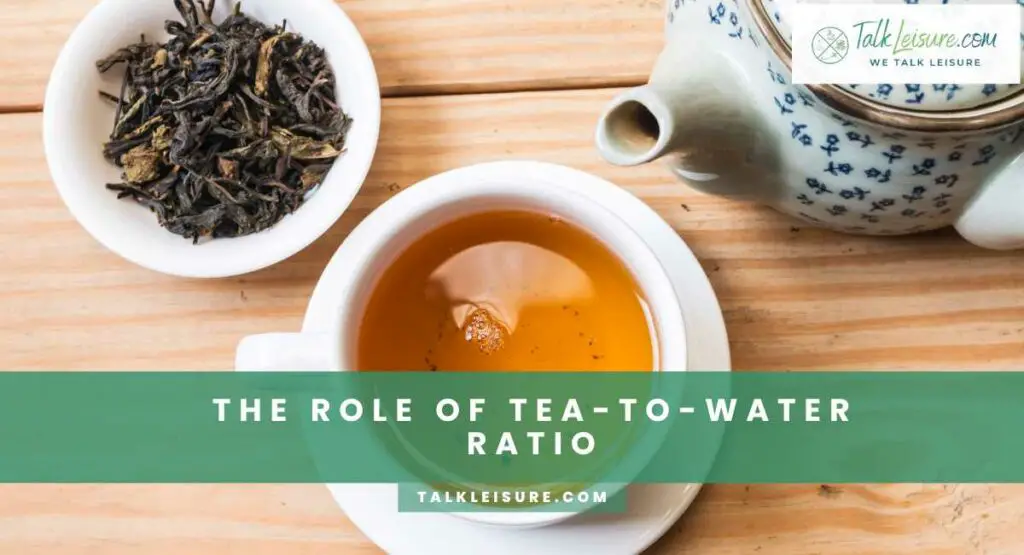
Ah, dear reader, we’ve danced through the nuances of time and temperature, but now it’s time to talk about a less heralded yet equally crucial player in the tea-steeping ballet: the tea-to-water ratio. It’s the secret ingredient that can make or break your brew. Let’s dive in!
The Magic Ratio: Striking the Perfect Balance
Imagine a chef carefully measuring ingredients for a gourmet dish. In the world of tea, the ratio of tea leaves to water is our culinary masterpiece. Too much tea, and you risk an overpowering brew; too little, and the flavors might fall flat.
The Art of Measurement
The standard measure is one teaspoon of loose leaves per 8 ounces of water. However, don’t be afraid to adjust based on personal preference. Feeling adventurous? Experiment with different ratios and discover your own tea-tasting nirvana.
The Leaf Dance: Loose Leaves vs. Tea Bags
Now, let’s talk about the dance floor itself. Loose leaves have more room to breathe, allowing for a fuller infusion of flavors. Tea bags, while convenient, can sometimes lead to a less nuanced brew due to the confined space.
The Tea Type Factor
Different tea types have their own preferences. Black teas often benefit from a slightly higher leaf-to-water ratio for a bolder flavor profile. Green teas, being more delicate, may require a lighter touch. Adjust accordingly to suit the character of your chosen brew.
Consider Your Vessel
The vessel you use for steeping also plays a role. A spacious teapot offers ample room for leaves to expand and unfurl, allowing for a more complete extraction of flavors. Teaballs and infusers can work well, but ensure they have enough room for the leaves to expand.
Timing and Technique
As with all things in the tea-steeping world, timing and technique are your allies. Experiment with different ratios and steeping times to find what works best for you. The beauty of tea-making lies in the endless opportunities for discovery.
The Grand Finale
And so, dear reader, armed with the knowledge of tea-to-water ratio, you are now poised to create brews that dance on your taste buds. Remember, like any great performance, finding the perfect ratio requires practice, intuition, and a touch of artistry.
Herbal Infusions: Steeping Techniques for Non-tea Herbal Brews
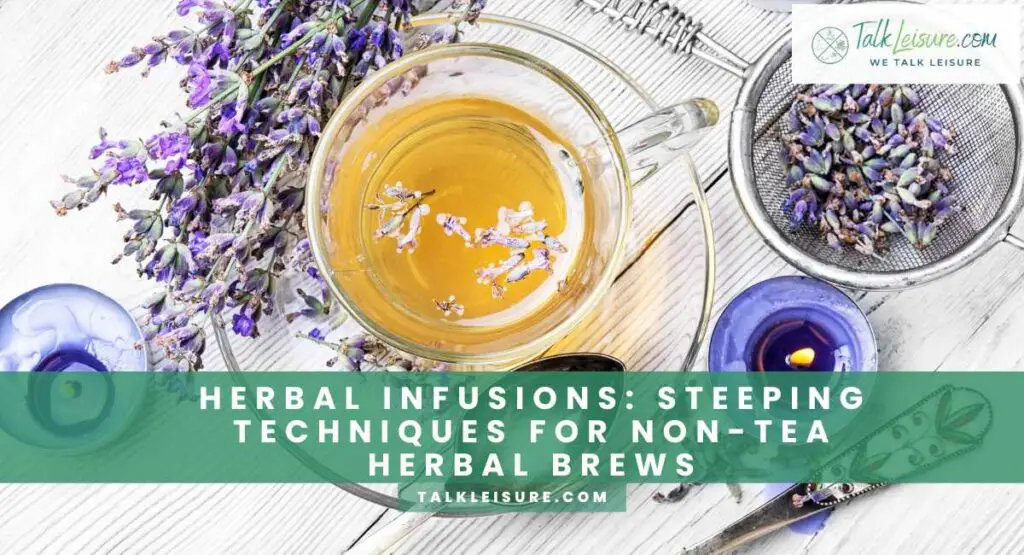
Ah, dear reader, we now venture into the world of herbal infusions, a realm where imagination knows no bounds. Unlike traditional teas, which hail from the Camellia sinensis plant, herbal infusions are crafted from an array of botanicals, each with its own unique flavor profile and potential health benefits.
The Art of Herbal Alchemy
Herbal infusions offer a canvas for creativity. With a plethora of herbs, spices, fruits, and flowers at your disposal, you can concoct brews that are both flavorful and therapeutic.
Measuring Your Medley
The quantity of herbal ingredients can vary widely, depending on the strength of flavor and potency you desire. As a starting point, a tablespoon of dried herbs per 8 ounces of water is a good rule of thumb.
Hot Water and Patience
While herbal infusions aren’t bound by the same rigorous standards as true teas, they still appreciate a gentle touch. Use water just below boiling, around 200°F (93°C), and let the herbs steep for a minimum of 5 minutes.
Extend the Dance
Unlike traditional teas, herbal infusions often benefit from a longer steeping time. Allow them to unfurl their full character over 10 to 15 minutes. For a stronger brew, don’t hesitate to extend the steeping time.
Pairing and Experimentation
Herbal infusions are versatile companions in the realm of tea-making. They can stand alone or be blended with traditional teas and other botanicals for a truly customized brew. Consider pairing herbs like chamomile with mint for a soothing bedtime elixir, or combining hibiscus with rose hips for a vibrant, vitamin-packed infusion.
The Herbal Apothecary
Each herb carries its own potential health benefits and flavors. For instance, peppermint can soothe the digestive system, while lavender offers a calming aroma and taste. Research the properties of your chosen herbs to create brews that cater to your unique needs and preferences.
A Symphony of Flavors
In the world of herbal infusions, the only limit is your imagination. Blend, mix, and experiment to create brews that resonate with your taste buds and provide a sip of nature’s bounty.
So, dear reader, step into the herbal apothecary and let your creativity run wild. With the right combination of herbs and a touch of patience, you’ll brew concoctions that are both delightful and beneficial.
The Importance of Selecting High-Quality Tea
Dear reader, as we embark on this tea-steeping journey, it’s imperative to begin with the cornerstone of a truly exceptional cup: the tea itself. The quality of the tea leaves you choose will ultimately determine the depth, complexity, and overall experience of your brew.
Discerning Palates: The Quest for Quality
Much like a painter selects the finest canvas and brushes, a tea connoisseur seeks out the highest quality leaves. The provenance, processing, and craftsmanship all come into play in the world of tea selection.
Single-Origin Elegance
Single-origin teas, much like fine wines, boast a unique terroir. They’re a reflection of the soil, climate, and traditions of a specific region. Each sip is a journey to that very place, an exploration of its nuances and character.
Artisan Blends: The Masterpieces
Artisan blends, crafted with precision and creativity, offer a symphony of flavors. Master blenders carefully combine different teas and herbs to create harmonious, complex profiles that can be an adventure for the palate.
The Tale of Processing: Handpicked vs. Mechanized
Handpicked leaves, a labor-intensive practice, are a testament to the care and attention that goes into their selection. Mechanized harvesting, while efficient, can sometimes lack the finesse and discernment of human touch.
Trustworthy Sources: A Tea Lover’s Sanctuary
When seeking high-quality tea, look for reputable sources and trusted brands. Seek out establishments that value transparency, sustainability, and a genuine passion for the art of tea-making.
Taking the Right Type of Water
Ah, the unsung hero of tea-making: water. It’s not just about H2O; it’s about the quality and composition of the water you choose. After all, it’s the canvas upon which the tea leaves will perform their magic.
Pure Elegance: The Quest for Quality Water
Start with water that you’d be happy to drink on its own. Fresh, filtered water without strong odors or flavors is ideal. It sets the stage for a clean, pure infusion.
Tap Water: The Wild Card
Depending on your location, tap water can be a reliable partner or a trickster in the tea-making process. Consider using filtered or bottled water if your tap water has strong odors or flavors.
The Temperature Tango
Consider the temperature of your water, as discussed in Section 5. Remember, it’s not just about how hot it is, but how well it complements the tea you’ve chosen.
How Many Tea Leaves Should Be Used?
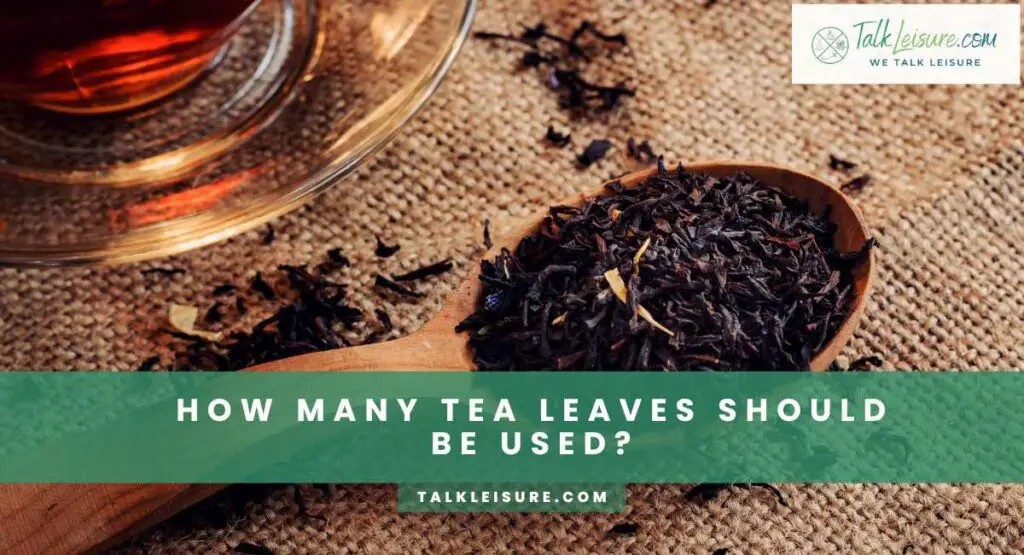
Dear reader, it’s time to address the age-old question: how much is just enough when it comes to tea leaves? The answer lies in achieving that perfect balance, where the leaves have ample room to express themselves, yet don’t overwhelm the brew.
The Golden Rule: One Teaspoon per Cup
A standard measure is one teaspoon of loose leaves per 8 ounces of water. However, don’t be afraid to adjust based on personal preference.
Loose Leaves vs. Tea Bags
Remember, loose leaves have more room to breathe, allowing for a fuller infusion of flavors. Tea bags, while convenient, can sometimes lead to a less nuanced brew due to the confined space.
The Tea Type Factor
Different tea types have their own preferences. Black teas often benefit from a slightly higher leaf-to-water ratio for a bolder flavor profile. Green teas, being more delicate, may require a lighter touch.
Experiment and Discover
The beauty of tea-making lies in the endless opportunities for discovery. Feel free to experiment with different ratios and discover your own tea-tasting nirvana.
Conclusion
In the grand tapestry of tea-steeping, we’ve embarked on a flavorful odyssey. From mastering steeping times and water temperatures to understanding the nuances of oxidation levels, we’ve unraveled the secrets behind a perfect brew.
We’ve explored the art of herbal infusions, danced with the elements of nature, and even ventured into the world of multiple steepings. Through it all, one truth remains: tea is not just a beverage, but a journey of discovery.
So, dear reader, armed with knowledge and a dash of creativity, may your future steepings be a symphony of flavors, a testament to the boundless wonders of this ancient elixir. Cheers to many more cups of tea and endless tea-steeping adventures!
Frequently Asked Questions
- Does steeping tea longer increase flavor?
Yes, steeping tea longer generally intensifies its flavor. However, there’s a limit. Overstepping can lead to bitterness and astringency. It’s essential to find the right balance to achieve optimal taste.
- Does expensive tea taste better?
Expensive tea often offers a more nuanced and complex flavor profile due to higher quality leaves and careful processing. However, taste is subjective. Some may prefer the subtleties of a pricier tea, while others may find value in more affordable options.
- How can you tell if tea is high quality?
High-quality tea exhibits several key characteristics:
- Appearance: Look for whole, unbroken leaves or large leaf fragments rather than dusty, broken bits.
- Aroma: Fine tea should have a fresh, distinct fragrance that matches its type (e.g., floral for oolong, grassy for green).
- Flavor: It should deliver a rich, complex taste that aligns with its type and origin.
- Infusion: The brewed leaves should unfurl fully and evenly, indicating proper processing.
- Aftertaste: Quality teas often leave a lingering, pleasant aftertaste.
- Origin and Source: Single-origin teas from reputable estates or regions are generally higher quality.
- Price: While not the sole indicator, higher-quality teas tend to be priced accordingly.
Remember, personal preference also plays a significant role in determining the “best” tea for an individual.




